By Grace Brooks, HFCI volunteer
On July 1, 1967, The Northern Virginia Sun informed its readers of the start of a new local tradition, stating, “The Fairfax City Council is cooperating with the Delta Alpha Chapter of Beta Sigma Phi, an international women’s society, in sponsoring the first annual Fourth of July Parade beginning at 7 p.m. at Fairfax High School.”[1] The article laid out the parade route, beginning at the high school and continuing to follow Cedar Avenue to Chain Bridge Road, turning on Lee Highway, taking a left on Oak Street, and disbanding the procession a little past the American Legion Hall on 1st Street. In addition to the parade, there would be an evening ceremony and a competition for the best parade float, with local businesses donating prizes. Fairfax City’s Fourth of July parade has formed an integral part of local Independence Day festivities for almost sixty years. We can gain an insight into how this tradition has evolved by using regional newspapers to understand how the celebration reflected historical events within the local community and the United States.
The first parade, in 1967, marked a period of rapid population growth in Fairfax County. As the number of residents swelled, so did the excitement for the festivities. The second year, 1968, saw the parade gaining momentum. Starting from Fairfax High School at 7 p.m, the parade displayed the community’s active participation.[2] The Fairfax High School Marching Band, the Fairfax Police Youth Club Drum and Bugle Corps, the Liberty Rising Stables, The American Legion, the Optimist Club, and the Fairfax-Prince William Council of Beta Sigma Phi were just a few of the entries. The parade also featured decorated cars, the American majorettes, and the Junior Rifle Club, among others. The Northern Virginia Sun, reporting on the parade, noted the large turnout: “Hundreds lined the streets in Fairfax City as they watched a parade which featured high school sweethearts and local beauty contest winners.” [3]
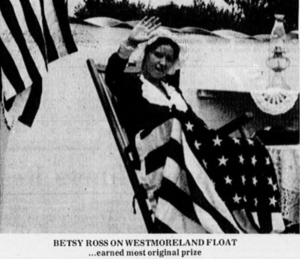
By 1971, the Fairfax City Parade had around eighty units, including the Highlanders Drill Team from McLean High School and the Precisionettes from W.T. Woodson High. Still, the organization that gained the most attention was the twenty majorettes from Cenon, France, who would participate in the procession and, with an accompaniment provided by The U.S. Navy Band would perform following the parade.[4] Reporting on the parade the next day, the Northern Virginia Sun commented, “Fairfax City had its parade with 20 French majorettes offering a glimpse of Gallic beauty to those who turned out to celebrate the holiday. ” While not the most progressive representation of the events of the parade, it nevertheless speaks to some of the perspectives at the time.[5]
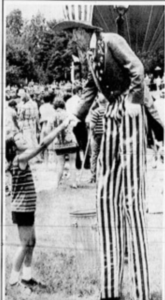
Four years later, in 1975, the parade gained twenty-five thousand spectators and boasted over one hundred units participating in the event. In the 1975 Fairfax City Fourth of July parade, the streets bustled with entries from antique cars to decorated bicycles, the Virginia Patriots who won best Pom-pom group, the First Virginia Civil War Volunteers who won best marching unit, and the “Betsy Ross” float of Westmore winning most original float. Heading the parade was Uncle Sam, who, for many parades to come, would continue to be the leader of the procession.[6] The 1978 parade continued in the tradition of unexpected historical floats, with Club Scout Troop 882 crafting a float designed to represent George Washington Crossing the Delaware River. However, on this occasion, he only crossed University Drive.[7]
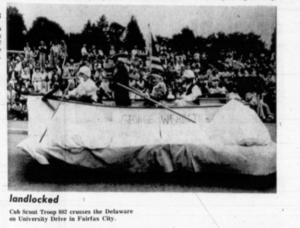
Enthusiasm for the parade continued into the early 1980s. The 1982 parade featured the Flying Circus Aerodrome performing a low-level flyover of the parade route in biplanes from the 1920s and 1930s. The annual Old Fashioned Fireman’s Day followed the parade, ending with a thirty-minute fireworks display.[8]
By 1991, around 45,000 spectators watched the parade, which the Fairfax Connection insisted was a “celebration of the small-town values that Fairfax residents like to hold dear.” According to one man from Annandale who had watched the parade for the last twenty years he expressed, “I swear, on days like this, Fairfax must be the most patriotic spot on earth.” However, despite the long tradition of the parade, according to the City Special Events Coordinator Joyce Garton, the celebration meant something different on that Independence Day in the early 1990s; the parade stood as “an all-purpose, post-Desert Storm celebration.” [9]
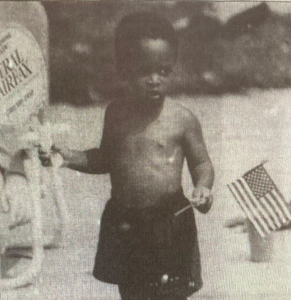
The parade in Fairfax continually operated within the context of the larger events facing the Nation. Even from the early days of the parade, accounts of the patriotic festivities were nestled beside news articles mourning the loss of life in the Vietnam War, the distrust over the events of Watergate, and concerns over Soviet activity abroad. Perhaps the clearest example of the local parade operating within the broader events of the Nation comes from the 2002 Fourth of July celebration, as the American people grieved the terrorist attacks that occurred the previous September.
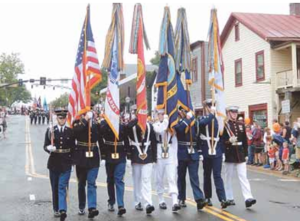
For the parade following the 9/11 attacks, the chosen theme was “America Stands Proud,” and the turnout to the parade reflected that fact. In interviews conducted by the Fairfax Connection, spectators at that event reflected upon the distinct emotions present that year. One resident commented that she often attended the parade but that this year, “You see a lot more red, white, and blue [than in years past].” The designer of the parade logo for that year, Jilliane Tyson, confirms this, stating that though the parade has “always been special, it’s even more special after what we went through as a nation.” As the parade traveled down Main Street, politicians rode on horseback, and activists participated in the event; the parade proved to be a time for the residents of Fairfax to gather and reflect upon the devastation the Nation faced.[10]
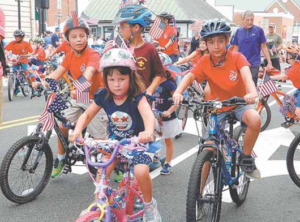
Throughout the 2000s, the parade continued, growing as the population of Fairfax continued to rise. In 2016, the parade celebrated its fiftieth anniversary, a testament to its enduring legacy. The tradition of Fairfax’s Independence Day parade continued through the COVID-19 pandemic, with the 2020 celebration adapting to the circumstances by avoiding large crowds and traveling through neighborhoods to ensure social distancing. The chosen theme of the “Wave Parade” year was “There’s no Place Like Home.”[11] As the parade enters its 58th year, it remains a vital link that connects current residents to their past, serving as a reminder of the community’s rich history and shared values.
[1] Ellen Remington, “Fourth of July Holiday Fare Planned to Suite All: Fireworks Picnics Follow the Parades.” Northern Virginia Sun, July 1, 1967, Page 2.
[2] Paula Herbut , “4th Plans Include Night Fireworks.” Northern Virginia Sun, July 1, 1968, Pages 1-3.
[3] Rona Cherry, “Thousands View Area Fireworks Displays in Northern Virginia.” Northern Virginia Sun, July 5, 1968, Page 1.
[4] “Big Parades to Celebrate 4th in Area.” Northern Virginia Sun, July 3, 1971, Page 1.
[5] “Holiday Death Toll Set at 4; Area Spared.” Northern Virginia Sun, July 5, 1971, Page 1.
[6] “10th Fairfax City Fete.” Northern Virginia Sun, July 5, 1975, Page 2.
[7] “N. Va.State Celebrates July 4th.” Northern Virginia Sun, July 5, 1978 Page 1-3.
[8] “Communities Plan Special Activities.” Northern Virginia Sun, June 3, 1982, Page 3.
[9] Howard Wolfson, “Parade reflects small-town values: Fairfax’s 25th Annual July 4 Celebration attracts 45,000 people.” The Connection: Newspaper of City of Fairfax, July 11, 1991, Page 3.
[10] Mike Salmon, “Humidity, Patriotism Fill Streets at Parade,” The Connection: Newspaper of City of Fairfax, July 7-11, 2002, Page 16.
[11] “Fairfax City’s July 4th Wave Parade” The Connection: Newspaper of City of Fairfax, July 9-15, 2020, Page 8.
Help Preserve and Protect Fairfax City's Future
